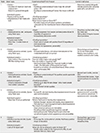Abstract
Purpose
The purpose of this study was to determine the effects of smartphone apps applying BodyThink program on BMI, percentage of body fat, skeletal muscle rate, body image, and self-esteem of adolescent girls.
Methods
Sixty-eight high school girls with a BMI of over 25kg/m2 were recruited to participate in this study. Girls from four schools were divided into two groups: the experimental group, which used the smartphone apps applying BodyThink program, and the control group, which used smartphone apps and small group counseling. The experimental group received the BodyThink program 6 times, scheduled once a week, with each session lasting 40~50 minutes. Test measures were completed before and after the 6 week intervention period for all participants. Collected data was analyzed using Shapiro-Wilk test, descriptive statistics, χ2 test, independent t-test, Mann-Whitney U test with the SPSS/WIN 18.0 program.
Notes
References
1. Ministry of Education. School health inspection sample survey in 2013 [Internet]. Sejong: Ministry of Education;2014. cited 2014 February 26. Available from: http://www.moe.go.kr/web/45859/ko/board/view.do?bbsId=294&boardSeq=52706.
2. Korean Society for the Study of Obesity. Obesity treatment guidelines. Seoul: Author;2012. p. 1–183.
3. Chung IJ, Lee JY. The impact of obesity and satisfaction with appearance on self-esteem in adolescence: Focusing on the moderating effect of gender. Ment Health Soc Work. 2011; 38:60–80.
4. Lee CS, Nam SW, Yeo JK. Understanding of constraining factors of physical activity of girls. Korean Soc Study Phy Educ. 2013; 17(4):57–76.
5. Kang JH. Adolescent: Obesity, internet/game addiction [Internet]. Daejeon: Biotech Policy Research Center;2014. cited 2014 July 14. Available from: http://www.bioin.or.kr/board.do?num=246344&cmd=view&bid=report.
6. Kim HK, Kim YS. The effects of smartphone application to increase physical activity among university students. Korean J Phys Educ. 2012; 51(5):457–466.
7. Carter MC, Burley VJ, Nykjaer C, Cade JE. Adherence to a smartphone application for weight loss compared to website and paper diary: Pilot randomized controlled trial. J Med Internet Res. 2013; 15(4):e32. DOI: 10.2196/jmir.2283.
8. Smith JJ, Morgan PJ, Plotnikoff RC, Dally KA, Salmon J, Okely AD, et al. Smart-phone obesity prevention trial for adolescent boys in lowincome communities: The ATLAS RCT. Pediatrics. 2014; 134(3):e723–e731. DOI: 10.1542/peds.2014-1012.
9. Dishman RK, Hales DP, Pfeiffer KA, Felton GA, Saunders R, Ward DS, et al. Physical self-concept and self-esteem mediate cross-sectional relations of physical activity and sport participation with depression symptoms among adolescent girls. Health Psychol. 2006; 25(3):396–407. DOI: 10.1037/0278-6133.25.3.396.
10. Jacobson D, Melnyk BM. Psychosocial correlates of healthy beliefs, choices, and behaviors in overweight and obese school-age children: A primary care healthy choices intervention pilot study. J Pediatr Nurs. 2011; 26(5):456–464. DOI: 10.1016/j.pedn.2011.07.001.
11. Lim HJ, Park HR. A study on the obesity situation of youth and children and policy measures. Seoul: National Youth Policy Institute;2009. Report No.: Research Report 09-R10.
12. Kim MJ. Discrimination against obese women and their diet: Centered on women in their 20-30s [master's thesis]. Seoul: Korea University;2014. 1–86.
13. Richardson SM, Paxton SJ, Thomson JS. Is BodyThink an efficacious body image and self-esteem program? A controlled evaluation with adolescents. Body Image. 2009; 6(2):75–82. DOI: 10.1016/j.bodyim.2008.11.001.
14. Australian Government Office for Youth. Body image: Information paper [Internet]. Canberra, AU: Author;2008. cited 2014 May 18. Available from: http://www.youth.gov.au/sites/Youth/bodyImage.
15. Jun MK, Ha JY. Effects of a smart phone weight loss program on obesity and body composition in adolescents. J Korean Public Health Nurs. 2013; 27(1):102–112. DOI: 10.5932/JKPHN.2013.27.1.102.
16. Cash T, Pruzinsky T, Hartley P. Body images. Development, deviance and change. New York, NY: The Guilford Press;1990. p. 337–349.
17. Rosenberg M. Society and the adolescent self-image. Princeton, NJ: Princeton University Press;1965. 1–326.
18. Yang TH. Falll in app [Internet]. Seoul: IT Today;2013. cited 2013 November 7. Available from: http://www.ittoday.co.kr/news/articleView.html?idxno=41143.
19. Mojgan AH, Alipour A, Janbozorgi M, Hajihosseini R, Shaghaghi F, Golchin N, et al. Lipid profile improvement after four group psychological interventions in combination to nutritional and physical activity instructing among overweight and obese individuals. Iran J Public Health. 2013; 42(1):86–95.
20. Kim HS, Park YH, Park HB, Kim SH. Estimation of effects of factors related to preschooler body mass index using quantile regression model. Asian Nurs Res. 2014; 8(4):293–299. DOI: 10.1016/j.anr.2014.07.005.
21. The Butterfly Foundation. Workshops for young people in schools [Internet]. Sydney, AU: Author;2015. cited 2015 September 8. Available from: http://thebutterflyfoundation.org.au/for-young-people/.
22. Lee W, Chae YM, Kim S, Ho SH, Choi I. Evaluation of a mobile phone-based diet game for weight control. J Telemed Telecare. 2010; 16(5):270–275. DOI: 10.1258/jtt.2010.090913.
23. Kim YH, Kim HS, Kang SJ. Effects of obesity management program on changes in body mass, physical activity and its related psychological variables in obese adolescents. Korean J Sport Exerc Psychol. 2013; 24(1):193–208.
24. Lee HM, Ha YS. Mediation effects of self-esteem in the relationship between body image and depression of elementary school students. J Korea Elem Educ. 2014; 25(3):19–33.
25. Lavender JM, De Young KP, Anderson DA. Eating disorder examination questionnaire (EDE-Q): Norms for undergraduate men. Eat Behav. 2010; 11(2):119–121. DOI: 10.1016/j.eatbeh.2009.09.005.




 PDF
PDF ePub
ePub Citation
Citation Print
Print






 XML Download
XML Download